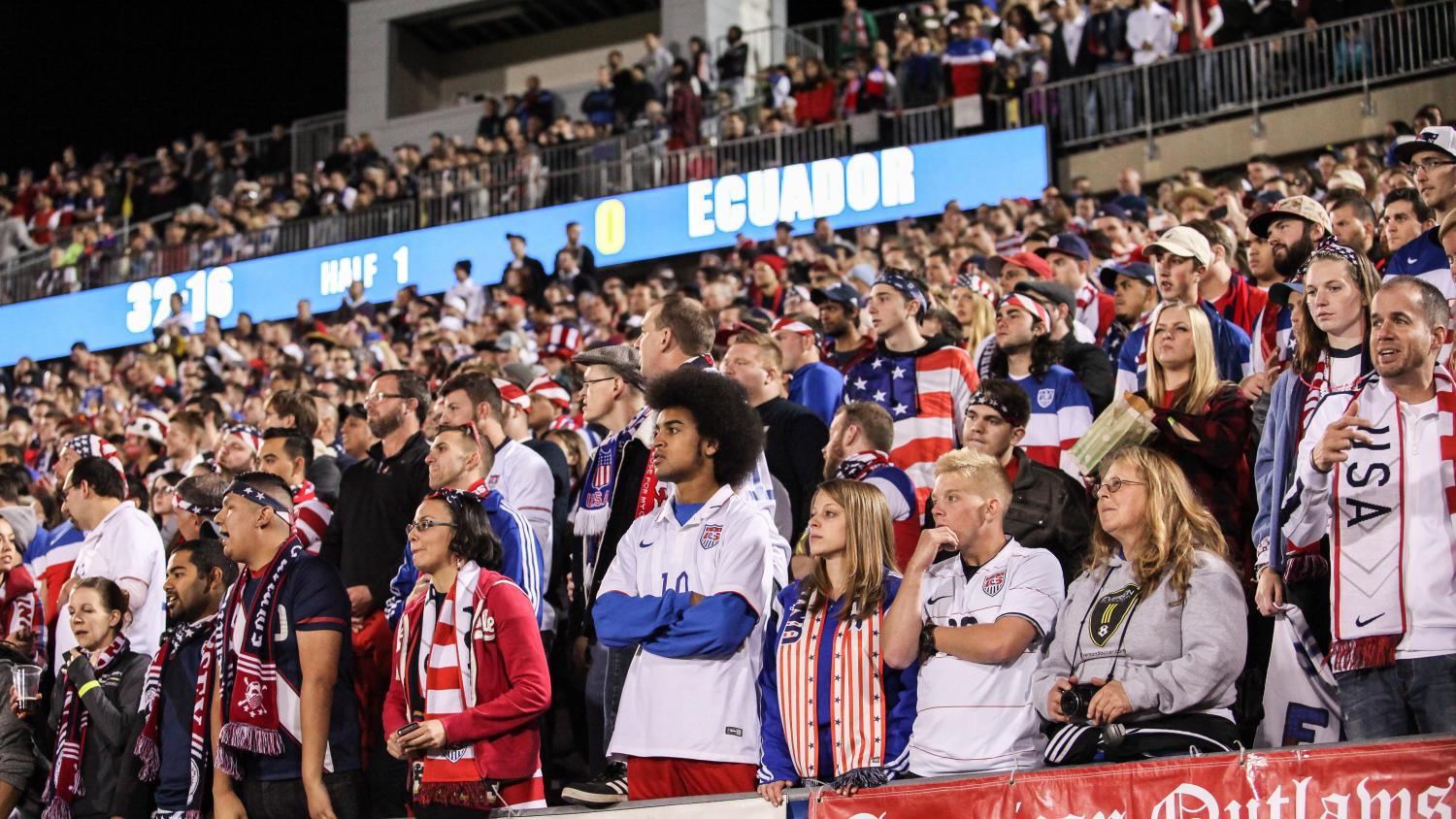Months after the USMNT failed to qualify for the 2018 World Cup, a new wave of headlines confirming "US Not In World Cup 2018" has dampened the mood of America's casual soccer fans who tune into three or four games every four years.
News of the U.S. joint bid with Mexico and Canada winning the rights to host the 2026 World Cup has given those fans something to be excited about, but the USMNT's absence from this year's World Cup is nonetheless disappointing.
The blow-by-blow account of what happend on that ill-fated October night in Trinidad never becomes easier to digest. CONCACAF is arguably the weakest qualifying region, and the U.S. couldn't even finish in the top four of the final qualifying group of six nations.
The USMNT had competed in the previous seven World Cups dating back to 1990, after not having qualified from 1954-1986. Port of Spain in Trinidad and Tobago was the site where the USMNT finally broke its qualification drought in 1989. Twenty-eight years later and 25 miles south in Couva, the USMNT's qualification streak ended.
Heading to Trinidad only needing a draw to at least qualify for the AFC-CONCACAF playoff, the USMNT stumbled out of the gate and never recovered from conceding two early goals. After the game, players were dejected, pundits were delirious and fans cycled through sadness, anger and disbelief.
The initial shock at failing to qualify soon gave way to an undercurrent that had long warned of a USMNT apocalypse. Everyone with any interest in the USMNT took a stab at explaining the issues facing U.S. soccer and offering their solutions. Consensus was elusive.
So why is the U.S. not in the World Cup this summer? The short answer is they played a bad game against Trinidad. But it's not that simple.
The most pressing problems facing the USMNT range from the exorbitant cost of youth soccer to the developmental challenges MLS has faced.
Why Is US Not In World Cup?
Pay-To-Play
With most competitive youth soccer taking place in structured leagues across U.S. Youth Soccer, U.S. Club Soccer and U.S. Soccer, parents must shell out precious dollars to keep their kids in the game. Relative to other countries, there are fewer pick-up games and more travel tournaments. Those are costly.
It would help if U.S. Soccer allocated a large portion of its $100 million surplus to youth soccer to make it more affordable. More pressing, though, is finding a sustainable way to competitively develop players absent the high costs of travel, facility rental and coaching.
It's true several MLS teams make participation on their development academy teams free. If an uber talented, underprivileged 12-year-old makes it onto FC Dallas' U12 DA team, he'll be set. The problem is that if a similar player just misses the cut, he's left with few options. Some unaffiliated DA teams will offer scholarships, but the reality is the current system will miss out on late bloomers whose families don't have the means to pay thousands of dollars every year for club soccer.
College Soccer
On its face, player development is stunted in college. Splitting time between being a student and a soccer player is a disadvantage relative to the player development systems of most nations.
So why do promising American players consistently choose to play in college? The answer is that college in the U.S. is extremely expensive relative to most countries.
If a player earns a full scholarship to a competitive private institution, that could be worth up to $250,000 over four years. That's a hard prize to give up for an uncertain future as a soccer professional. If a player in the U.S. opts to play professionally and fails to progress, they'll be left to pursue a college degree without a scholarship and with the looming prospect of significant student debt.
In Spain, where fours years of college cost roughly $10,000, the risk-reward equation is entirely different. Being good at soccer in Spain doesn't translate to free education. And more importantly, there's no clear incentive to pass up on professional soccer and attend college immediately following high school.
Additionally, the high cost of college can be linked to pay-to-play. Parents in many cases are willing to shell out $5,000 per year if it means their kid has a chance at a scholarship down the road. Since most parents are delusional when it comes to their own child's playing abilities, the actual chance of earning a scholarship is almost always overestimated.
Nonetheless, the "sacrifice for a scholarship" mentality feeds a for-profit club soccer system and instills in players the ultimate goal of free college rather than professional development.
MLS and SUM
The debate over whether MLS is good or bad for U.S. Soccer has raged on since the league's inception. The advantages of having a strong domestic league include the ability to attract young players to the game and the resources MLS clubs now devote to their development academies.
The disadvantages have been the costs associated with building a league from scratch. U.S. Soccer has not escaped unscathed, and the USMNT's absence from the 2018 World Cup can be attributed to a suboptimal TV deal connected to MLS.
Since 2004, SUM, Soccer United Marketing, has served as the exclusive marketing partner of the USSF (United States Soccer Federation). SUM, whose board is comprised of MLS team owners, sells U.S. Soccer and MLS TV rights as a package deal, with its current USSF contract running through 2022.
MLS Commissioner Don Garber has claimed the USSF benefits from guaranteed cash flow as a part of its TV rights contract. The operative question, though, is whether the USSF could have made more money by selling its U.S. Soccer rights independent of those of MLS.
The answer is yes. There are many more USMNT fans than MLS fans, and even if the gap has narrowed, the package deal was in place even when MLS fan support was a fraction of what it is now.
The USSF effectively has subsidized MLS, trading a significant portion of its TV revenue for the promise of a domestic league that will improve the USMNT player pool.
One could argue the trade off has been mutually beneficial, but the way in which it was negotiated reeks of corruption. After serving as deputy commissioner for Major League Soccer, former USSF President Sunil Gulati assumed his old post with U.S. Soccer in 2006. His close ties with MLS and its owners led to a clear conflict of interest.
Essentially, if Gulati had concluded that the USSF should sell U.S. Soccer TV rights independent of MLS TV rights, his connections with MLS still would have led him to opt for the current package TV deal.
The issue of sharing TV revenue exemplifies how U.S. Soccer has sacrificed for MLS. All things being equal, having a strong domestic league is an advantage for a national team. But it's fair to ask if corporate corruption has caused the USSF to go too far in supporting MLS.
Participation Density
The U.S. has more than four million kids registered as soccer players in its youth ranks. That's a competitive number. It's a number 10 times the size of Iceland's population, yet the Viking nation will suit up in Russia while the USMNT is shut out.
Although the U.S. has strong youth participation, its geographic size makes it difficult for the best players in the country to compete against each other often. As the player development experiment in Iceland has demonstrated, there are distinct advantages of scale in youth participation.
Most USMNT players who have been capped since 2000 have come from eight metro areas where soccer is most popular, and Iceland's team is Reykjavik's best with a few outsiders sprinkled in.
Rather than aiming to increase youth participation at large, new USSF president Carlos Cordeiro should focus on improving player development in areas where youth soccer already has a strong presence. The value added of 100 new youth players in Los Angeles is greater than 100 new youth players in Milwaukee.
Young players improve if there are well-estabished networks of competition, leading all the way up to MLS affiliated development academies. The USSF needs to acknowledge that reality.
Conclusion
The prohibitive costs of college and pay-to-play youth soccer, the relationship between MLS and SUM and the lack of youth participation density have all been key challenges that are somewhat responsible for the USMNT's failure to qualify for the World Cup.
While improving the USMNT and the overall landscape of soccer in the U.S. remains a tall order, it's important to acknowledge how razor thin the margins are. If Clint Dempsey's left-footed strike in the 77th minute against Trinidad had deflected in off the post instead of wide, this article would have a decidely different tone.
Can the U.S. advance out of its group this year? Will the U.S. return to the quarters for the first time since 2002? Instead, we're left examining the structural issues of U.S. soccer, grasping for answers to headlines proclaiming: "Why Is US Not in World Cup 2018?"





